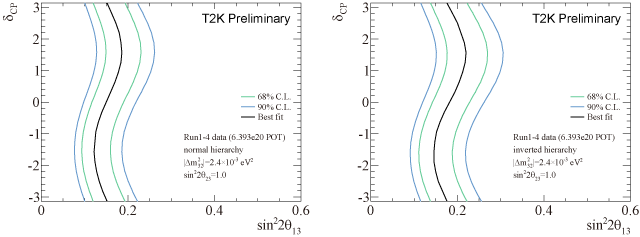T2K Results Restrict Possible Values of Neutrino CP Phase (2020)
The T2K Collaboration has published new results showing the strongest constraint yet on the parameter that governs the breaking of the symmetry between matter and antimatter in neutrino oscillations. Using beams of muon neutrinos and muon antineutrinos, T2K has studied how these particles and antiparticles transition into electron neutrinos and electron antineutrinos, respectively. The parameter governing the matter/antimatter symmetry breaking in neutrino oscillation, called δcp phase, can take a value from -180º to 180º. For the first time, T2K has disfavored almost half of the possible values at the 99.7% (3σ) confidence level, and is starting to reveal a basic property of neutrinos that have not been measured until now. This is an important step on the way to knowing whether or not neutrinos and antineutrinos behave differently. These results, using data collected through 2018, have been published in the multidisciplinary scientific journal, Nature on April 16.
– Published in Nature, the results are a major step forward in the study of the difference between matter and antimatter
https://www.nature.com/articles/s41586-020-2177-0
A preliminary data release for a subsequent analysis that includes 33% more neutrino mode data and various analysis improvements outlined in the T2K Neutrino 2020 talk can be found here available from here.
Observation of νe Appearance (Summer 2013)
The νe appearance analysis was performed on our entire data-set up to April 12th, 2013 (A beam exposure of 6.39×1020 p.o.t.). We observed 28 single-ring electron-like events at Super-Kamiokande while 4.64±0.53 events would be expected if sin2(2θ13) = 0. The probability of background fluctuation resulting in 28 or more events being observed is 9.9×10-14, which, when converted to a significance level, is 7.5σ. The fitted value of sin2(2θ13) is 0.150+0.039-0.034 (0.182+0.046-0.040) assuming δCP = 0, Δm223 = 2.4×10-3 eV2, θ23 = π/4 and normal (inverted) hierarchy. This is the first-ever observation of an explicit νe appearance channel.

Our results for the normal (left) and inverted (right) hierarchies. The areas between coloured lines show allowed regions of sin2(2θ13) for each value of δCP at 68% (green) and 90% (blue) confidence level. The black solid line is the best fit value of sin2(2θ13) for each assumed value of δCP and the mass hierarchy.



